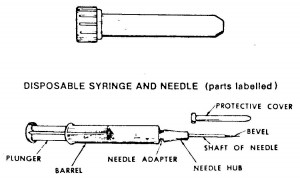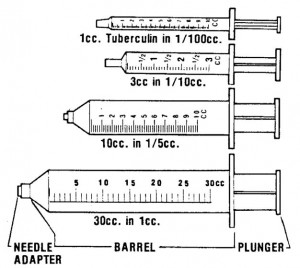Administering medicine by injection requires needles and syringes that are sterile, accurate in measuring dosages, and convenient to use.
Using the correct equipment for injection will minimize discomfort or danger to the patient. Figure 1-1 illustrates a disposable rigid plastic container and a disposable needle and syringe.
[otw_is sidebar=otw-sidebar-1]
a. The needle is a tube with a cutting edge that punctures beneath the protective area of the skin.
It is made of steel or other metal and is generally disposable. The parts of a needle consist of a lumen (cavity through which medication flows), bevel (slanted tip/cutting edge), hub, and cannula (shaft) (see figure 1-2).
The needle comes in standard lengths from one-half inch to six inches (see figure 1-3). The length is determined by measuring from the tip of the point to the junction of the shaft. The choice of length depends on the route ordered for administration.
The choice of needle gauge depends upon the thickness (viscosity) of the medication. The gauge is indicated by numbers 14 to 27. The higher the gauge (size) number, the smaller the diameter of the needle. A small gauge is needed for viscous medications; a large gauge is needed for “thin” or watery medications.
b. The syringe is the instrument used for injecting liquids.
It consists of a barrel, plunger, and needle adapter that attaches to the needle (see figure 1-4). The plunger pushes the medication through the barrel into the needle. The barrel is marked in cubic centimeters/ milliliters (cc/ml). Syringes come in different sizes




